Bombardier – worldwide experience in high-speed
Posted: 26 March 2009 | | No comments yet
Jürgen Jakob covers the history of Bomardier in the field of high-speed rail, from the first railway vehicle to reach 210lm/h to the present day.
Jürgen Jakob covers the history of Bomardier in the field of high-speed rail, from the first railway vehicle to reach 210lm/h to the present day.
Jürgen Jakob covers the history of Bomardier in the field of high-speed rail, from the first railway vehicle to reach 210lm/h to the present day.
Bombardier has long-standing credentials in the high-speed sector. The history of high-speed in Bombardier began back in 1903 with the first ever railway vehicle to reach a speed of 210km/h. The electrical railcar produced by former A.E.G. in Germany (see Figure 1 and Figure 2) set this speed record during a series of tests and demonstrated the future potential of railway transportation. This speed record stood for 28 years before it was eventually broken.
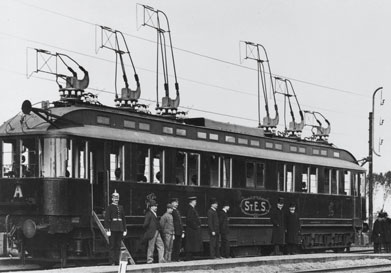

Figure 1: A. E. G. speed record electric car
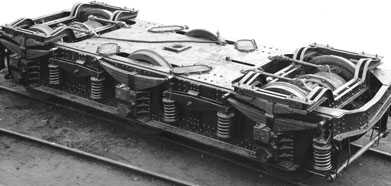

Figure 2: A. E. G. high-speed bogie 1903
Predominantly in Japan, France and Germany, specific programmes seeking to increase speeds were initiated in the 1950s and 1960s, thereby raising the attractiveness for long-distance travellers through shortening journey times and overcoming the capacity limitations of the railway lines. One important cornerstone for these programmes was set in 1965 during the international transport exposition in Munich. For the first time, a public passenger service in Europe was established with an operational speed of 200km/h. This used a locomotive hauled train running on bogies designed and manufactured in Kassel (former Henschel) and Siegen (former Waggon Union).
Another significant step in high-speed rail technology within Bombardier was the development of the very high-speed trains in Germany. Bogie experts from different Bombardier sites were at the leading edge of high-speed development, including Nuremberg (former MAN / MBB) with innovative concepts like the independent wheel technology or the intermediate frame bogie. The ICE2 started operation in 1991 with a 280km/h capability. Here again the trains’ coach bogies and power head bogies had their origins in Siegen and Kassel respectively (see Figure 3).
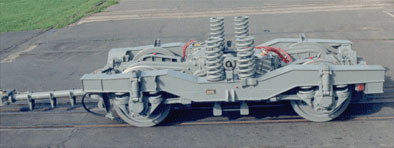

Figure 3: ICE1 motor bogie
Initiated by a joint research programme of German Railways and Japan Rail East, Bombardier created in 1996 the innovative TR400 high-speed bogie. This set out to significantly reduce the bogie weight, the wheel-to-rail forces and the aerodynamic drag levels (see Figure 4). Track tests at up to 392km/h in Germany and Japan then verified the potential of this bogie type, thereby further enhancing the high-speed rail technology base.
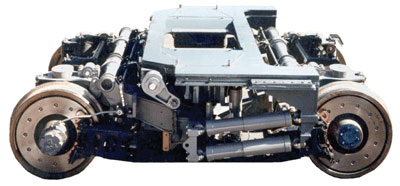

Figure 4: TR400 bogie
Bombardier’s strong high-speed bogie expertise is founded on all of these achievements accomplished by its famous former companies, which then later merged into Bombardier. Bombardier’s high-speed bogie technology has since been continually developed and is now setting the future trends.
At the forefront of high-speed bogie expertise
Since the 1980s, Bombardier has delivered more than 10,000 high-speed bogies operating within Central and Northern Europe, North America and China, with approximately 3,500 bogies for speeds over 250km/h. Bombardier has been a key player in the design and delivery of almost all recent major European very high-speed trains as well as in other significant international high-speed projects. The wide range of Bombardier’s high-speed bogie portfolio reflects this fact.
The bogie type used for the first generation of 280km/h trains in Germany (ICE) is a member of the FLEXX1 Fit bogie family. These are characterised through the use of steel coil springs for both the primary and secondary suspension stages and a fail-safe anti-hunting device utilising the friction damping principle (see Figure 5). This design provides an optimum balance between cost, reliability and comfort.
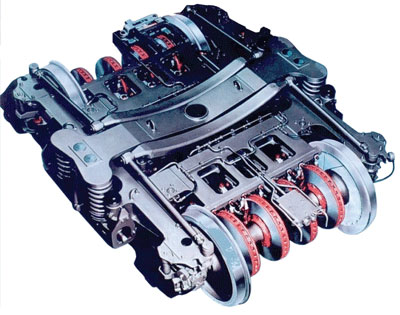

Figure 5: FLEXX Fit - ICE1 trailer bogie
FLEXX Link bogies are mounted under high-speed trains in Scandinavia and China. This bogie family is characterised by a robust design, a good curving performance and operational capability in extreme weather conditions. The CRH1 (China High Speed) has been developed to satisfy the high performance demands of the Chinese high-speed sector. With an operational speed of 220km/h, the CRH1 has been successfully tested at 250km/h and has high levels of reliability – running an average distance of 500,000km per year. The future ZEFIRO1 trains, ordered in 2007, are designed for overnight operations to support the rapidly increasing demand for comfortable long-distance travel. These new ZEFIRO1 trains feature the world’s first EMU sleeper cars capable of operation at up to 250km/h.
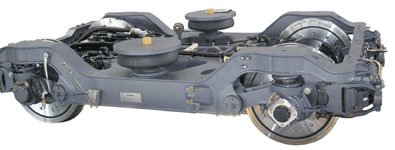

Figure 6: FLEXX Link - CRH1
With the innovative features of the extremely compact design, the FLEXX Eco bogie offers a 30% reduction in unsprung mass as well as the total bogie mass when compared with conventional bogies. Particularly in Great Britain where the track access charges are directly related to the track friendliness of the vehicle, these features bring about significant advantages for the train operator. In addition, the FLEXX Eco bogie also enables significant reductions in maintenance, energy consumption and noise emission. The inherent excellent running stability of the FLEXX Eco was proven during the previously reported TR400 tests and makes this bogie type ideally suited for high-speed applications.
The FLEXX Speed bogies represent well proven technology used on the latest generation of German Railways’ ICE. Bombardier is enhancing this design by using standardised, proven and reliable technologies, e.g. alternative wheelset guidance and primary suspension systems.
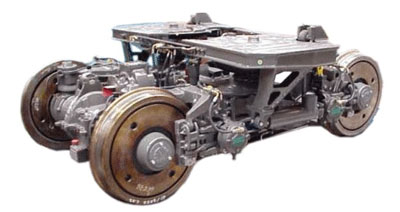

Figure 7: FLEXX Eco - Virgin Rail
Locomotive and power head bogies for high-speed are a specific challenge as these bogies have to combine the general requirements of high-speed operation (running stability, restricted axleload and track forces) together with the integration of powerful drive systems. This is a prerequisite for successful operation. One example is the FLEXX Power 350 of the AVE2 S-102 high-speed trains of RENFE in Spain. This bogie is characterised by its modern drive technology, which consists of an axle-hung light weight gearbox and a laterally suspended motor, which has twice the power output of the ICE3 drive. The maximum speed in operation is 330km/h.
As an add-on to existing bogie designs, Bombardier is offering the FLEXX Tronic technology, which consists of various modules such as active radial steering and active lateral suspension. The active radial steering system addresses the conflict of objectives between stable running on straight tracks and on the other hand smooth low force curve transition. A bogie, being equipped with active radial steering, behaves like a bogie with a very soft primary suspension when negotiating curved track sections, but like a bogie with a high wheelset yaw stiffness, when running at high speed on straight track. The advantages for the operator are track friendliness, minimised wear, noise and energy consumption. Numerous applications, from high-speed and tilting trains to light rail vehicles can reap the benefits of this technology.


Figure 8: FLEXX Speed
Another module of FLEXX Tronic is the active lateral suspension. It provides an improved ride comfort and whilst reducing lateral body-bogie displacements thus enabling a wider vehicle body profile to be adopted.
Within the ‘Green Train’ project in Sweden, Bombardier tested in 2007 and 2008 a FLEXX Link bogie fitted with FLEXX Tronic technology on a REGINA1 train at up to 282km/h. The FLEXX Tronic system incorporated both active radial steering and active lateral suspension. Together with the FLEXX Eco bogie, the FLEXX Tronic technology is part of the Bombardier ECO4 portfolio of ecologically friendly rail technologies.
Bombardier is continuously enhancing its high-speed bogie portfolio by using reliable and service proven technologies to be prepared for the growing worldwide Very High-Speed market. Bombardier’s approach is not to reinvent the wheel – in fact the opposite is the case. Particularly for top speeds of 300km/h and more, Bombardier trusts in its own reliable technologies. During the development process, the interaction and simultaneous engineering between the different design groups is also particularly essential, e.g. the close collaboration between the bogie Engineers and the aerodynamic specialists.
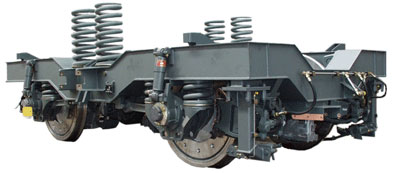

Figure 9: FLEXX Power 350
Two main aspects must be considered – primarily safety and reliability, secondly the design features that are explicitly important for Very High-Speed bogies. These features are:
Axle Guidance
Many different axle guidance systems are available. For the future application of a very high-speed bogie, Bombardier considers two particular solutions to be appropriate. Both types are already proven within our existing bogies.
Radius arm
This solution is widely used within high-speed and very high-speed bogies.
Leaf spring
This solution provides a very low unsuspended mass, low LCC figures and the bearing housing can be structurally optimised to provide a high bearing performance.
Traction Equipment Installation
For powered bogies incorporating bogie mounted traction motors, then it is a well known principle to ensure that the motor mass is decoupled from the sprung bogie mass. Thereby decreasing the moment of inertia around the vertical axis, which is essential for running stability. The principle of the Bombardier approach is shown below – the motor is installed into the bogie frame using rubber to metal elements which are relatively soft in lateral direction allowing the motor to move up to 10mm.
Bearing Performance
When it is considered that the bearings for the axles and gearboxes are installed within the unsprung environment of the bogie and that this is then combined with the high wheelset rotational speeds required for very high-speed operation, then it becomes obvious that special attention has to be paid to these elements.
Wheelset Design
For new bogies, Bombardier undertakes its wheelset design in-house, rather than leaving the responsibility to the wheelset manufacturer as it was often the case in the past. Incidents of late have encouraged Bombardier to adhere to this approach, especially with regard to axle design. Bombardier’s principle is to link the design guidelines to the maintenance guidelines. In other words – Bombardier design their axles in a way that ensures that an acceptable inspection regime for the operator can be set out.
Yaw Damping
Running stability is obviously a key element for high/very high speed trains. In addition to the conventional hydraulic damping principle Bombardier still considers the use of friction damping to be a valid alternative. Friction yaw damping offers:
- Reduced bogie yaw stiffness, lower lateral forces and less wear in tight curves.
- Longitudinal body-bogie decoupling and reduced bodyshell excitations thereby enabling improved comfort
- Improved reliability and lower maintenance
Features for Performance Monitoring
The new High-Speed TSI requires, as a minimum, the monitoring of running stability and axle bearing condition. In addition, Bombardier is prepared to provide a track condition monitoring system known as FLEXX Track. FLEXX Track is a sensor-based measurement system which is designed to monitor track conditions and evaluate their deterioration over time. It can also be installed on existing vehicles and the data acquisition is active during normal operation.
The information obtained through the installation of a FLEXX Track system can be used to identify and locate the following track irregularities:
- Track twist limit exceedence
- Vertical track irregularities
- Irregularities at joints, switches and crossings
- Railhead corrugation limit exceedence
Due to its functionality, FLEXX Track not only provides information to better inform the permanent way Engineers about the condition of their assets thus aiding their track maintenance planning, but it also enables an assessment of the consequences of any untoward track irregularities upon the bogie frames and potentially offers beneficial information with regard to the residual life assessment of the structural bogie components.
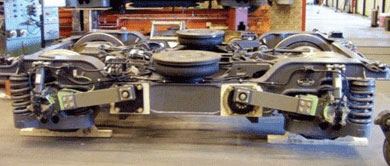

Figure 10: FLEXX Tronic
References
- Trademark(s) of Bombardier Inc. and its subsidiaries
- Trademark(s) of Third Parties








